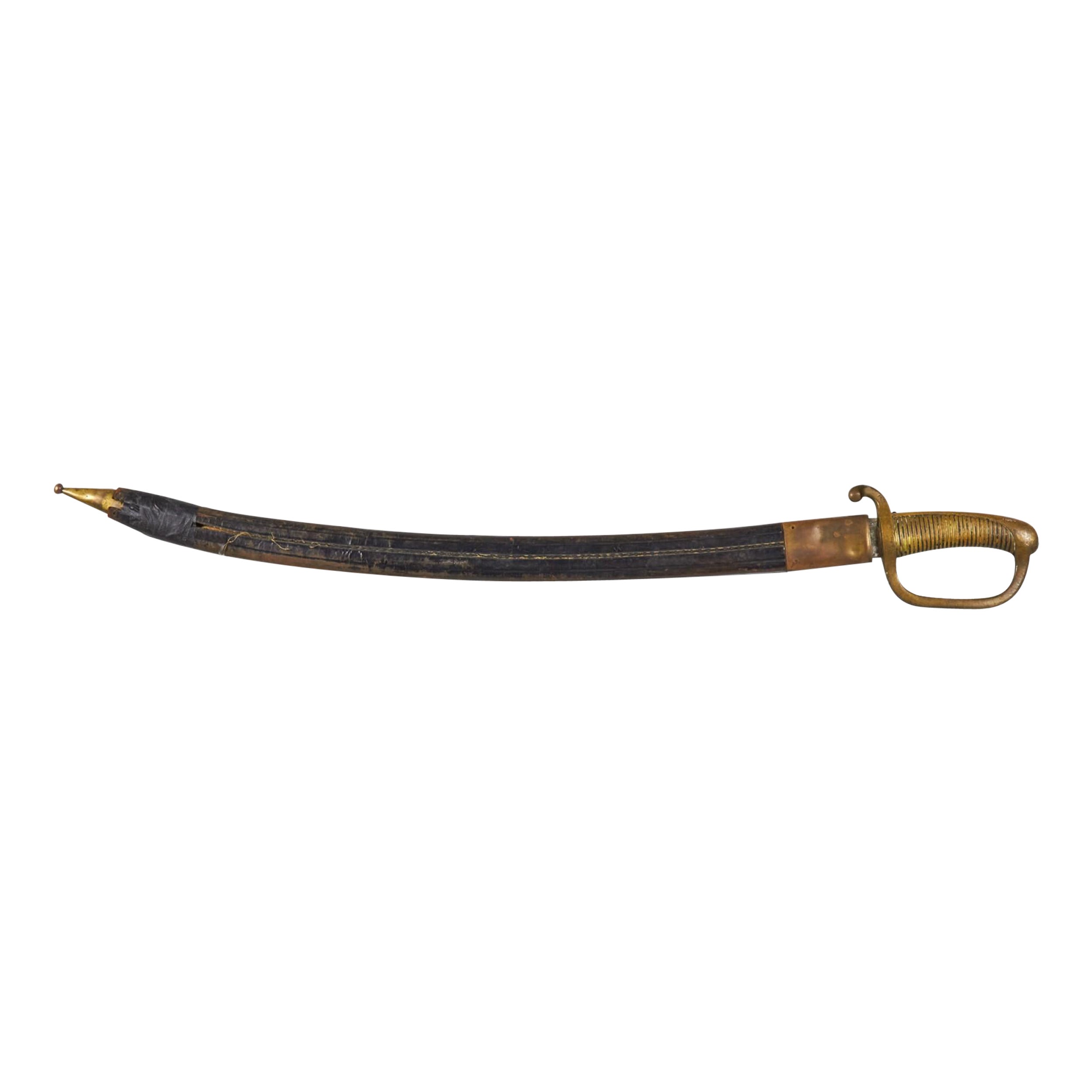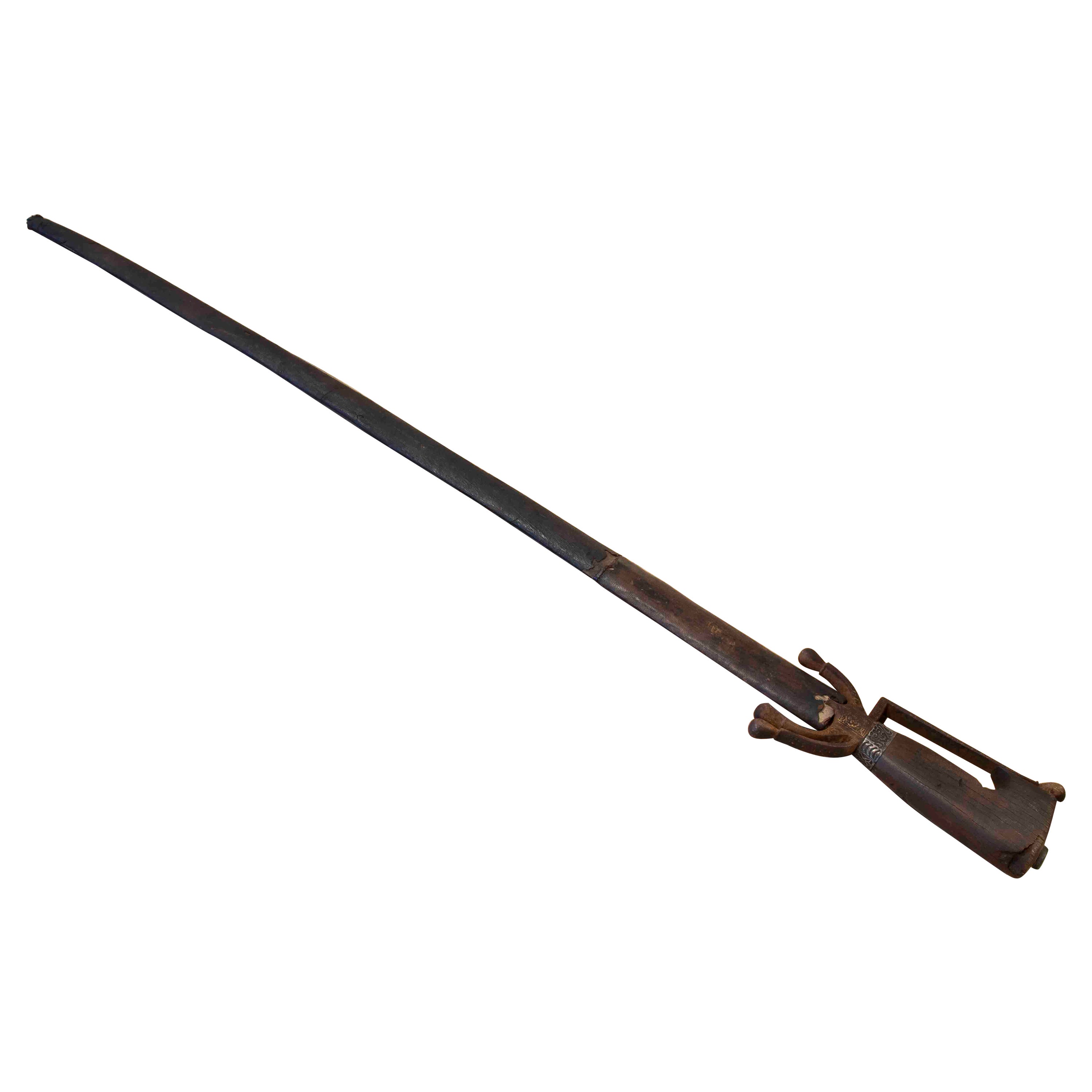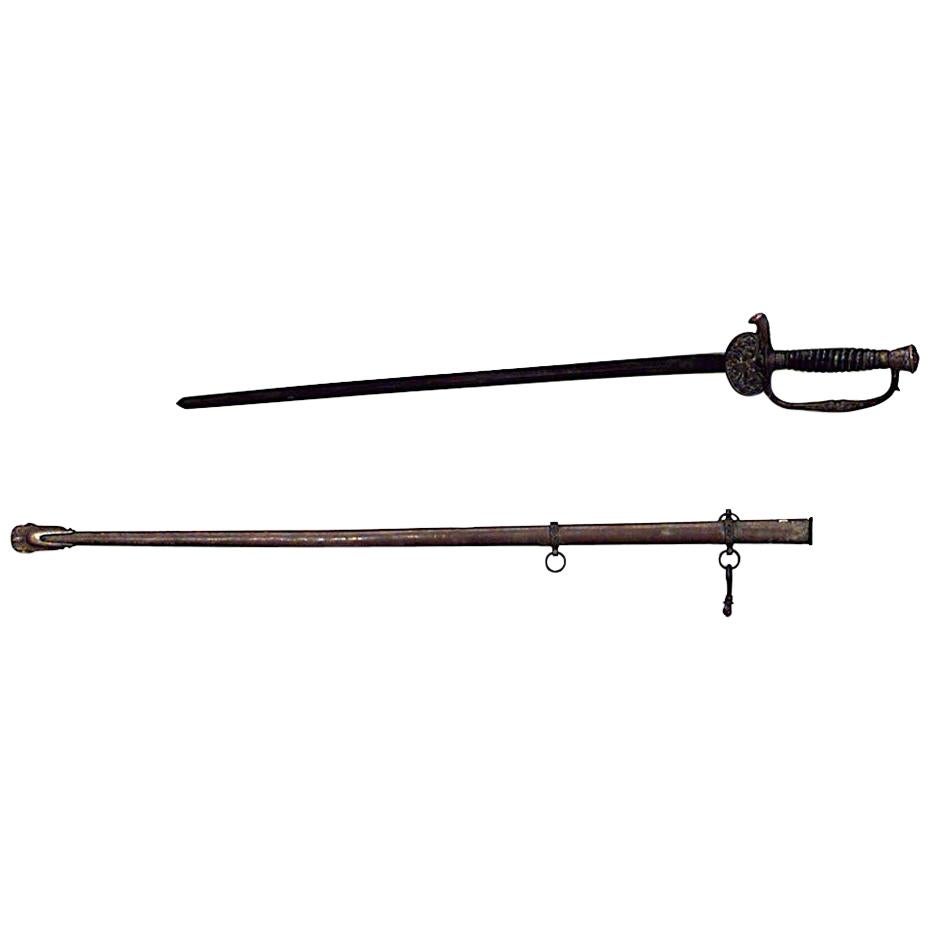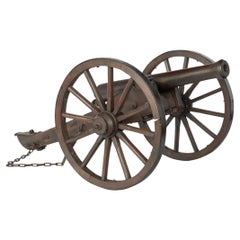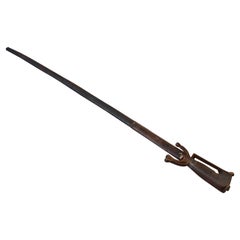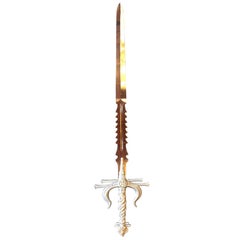Items Similar to Fine Presentation Sword Given to Lieutenant Charles Peake
Want more images or videos?
Request additional images or videos from the seller
1 of 21
Fine Presentation Sword Given to Lieutenant Charles Peake
$115,393.16
£82,500
€98,523.03
CA$157,855.53
A$176,644.77
CHF 92,235.60
MX$2,171,663.61
NOK 1,163,658.43
SEK 1,094,996.85
DKK 735,057.31
Shipping
Retrieving quote...The 1stDibs Promise:
Authenticity Guarantee,
Money-Back Guarantee,
24-Hour Cancellation
About the Item
A fine presentation sword given to Lieutenant Charles Peake as a token of gratitude by the Men of His Ship when recommissioned for Foreign Service in 1821, the citation reading, the curved hatchet point blade etched along its entire length with naval and martial motifs, a crowned garter, Neptune, the allegorical figure of Hope, and the dedication reading ‘Presented by the seamen of His Majesty’s Ship Euryalus to Lieunt Charles Peake; as a token of their esteem and gratitude: XXVIIIth Augst MDCCCXXI’, all amid foliate scrolls; the gilt copper stirrup hilt with lion’s head pommel, triangular langets with swagged and tied edges and displaying the stern of a ship in relief, border engraved cross piece with scrolling acanthus terminal, ornate knuckle bow in the form of winged Victory, wire bound horn grip; part scabbard of black leather with heavy gilt copper mounts and engraved in a plaque ‘Fiske late Read Portsmouth’, the locket and band well engraved with scrolls and arms against a seeded ground, each set with an oval medallion depicting Hope (locket) and Hercules fighting the Nemean Lion (band), and each with a suspension bracket in the form of a writhing dolphin (retaining the swivel clips from the belt, lower part of scabbard missing). English, 1821.
Literature: The presentation of this sword in 1821 (together with a silver vase) is recorded by William O’Byrne, ‘Naval Biographical Dictionary’ Vol 2' and his career history is written in full.
Footnote: The design of the sword clearly inspired by the £100 Lloyds Patriotic Fund swords-in particular the elaborate suspension rings on the scabbard and the compartmentalised decoration. This sword, however, was an individual commission rather than part of a larger scheme. The sword was presented to Lieutenant Charles Peake by the crew of the ship Euryalus when it was successfully recommissioned for foreign service in 1821. Peake had taken temporary charge of the ship that year and his shipmates’ gratitude was very clear as, in addition to this wonderful sword, he was given a beautiful presentation silver cup which is in the museum of the dockyard where Euryalus was built – Buckler’s Hard Museum in Hampshire.
PEAKE. (Lieutenant, 1814. f-p., 10; h-p., 30.)
Charles Peake was born 25 July, 1793, and died 2 Jan. 1847.
This officer entered the Navy, 26 Jan. 1807, as Fst.-cl. Vol., on board the Vestal 28, Capt. Edwards Lloyd Graham; under whom, until paid off in April, 1810, he was constantly employed in the Channel and North Sea, among the Western Islands, and at Newfoundland. He assisted during that period at the capture, with a large number of merchant-vessels, of L’Intrépide privateer of 20 guns and 125 men, and was on several occasions intrusted with the charge of a prize. In May, 1810, he became Midshipman (a rating he had attained in June, 1809) of the Pallas 32, commanded at first by Capt. Graham, and subsequently by Capts. Pringle Stoddart and Geo. Paris Monke. In command of one of the boats belonging to that ship Mr. Peake, while cruising on the coast of Norway, assisted in taking, at one time, two Danish privateers, mounting respectively 6 and 5 guns; and, at another, two Danish cutters. The Pallas being wrecked off St. Abb’s Head 18 Dec. 1810, he again, in the following Feb., joined Capt. Graham on board the Alcmène 38, fitting for the Mediterranean station, where he was soon afforded an opportunity of participating in much detached service. On 22 May, 1812, in particular, we find him (the Alcmène being at the time on a cruize to the Adriatic) present, in command of the Captain’s 6-oared gig, in a most gallant but sanguinary attack made by four boats, under Lieut. Edw. Saurin, upon an enemy’s armed convoy, the result of which was the capture of one of their principal vessels, after nearly the whole of the crew had been either killed or wounded. The slaughter on the part of the British was likewise dreadful – the pinnace alone sustaining a loss of at least 20 officers and men killed and wounded. Mr. Peake afterwards assisted at the cutting out of a vessel from under a battery; at the capture of a French national schooner, La Flêche, of 12 guns; and at the further cutting out, on the coast of Corsica, of two polacres and a xebec. On leaving the Alcmène, which ship had been latterly commanded by Capt. Jeremiah Coghlan, he was received, 6 March, 1814, on board the Caledonia 120, bearing the flag of Sir Edw. Pellew, by whom, after witnessing the fall of Genoa, he was nominated, 27 April in the same year, Acting-Lieutenant of a 74-gun ship of that name, commanded by Capt. Arthur Stow. On 1 July following his promotion was confirmed. He went on half-pay in Nov. 1814; and was next, 3 July, 1818, appointed to the Euryalus 42, Capts. Thos. Huskisson and Wilson Braddyll Bigland. On 27 Sept. 1820, having risen to the post of First-Lieutenant, Mr. Peake was appointed by the former officer, who had become Commodore on the Jamaica station, to the command of the Bann sloop, rendered vacant by the death of Capt. Stow of the Tamar, and the removal to that ship of the commander of the Bann. On the arrival, however, of the latter vessel at Halifax, Rear-Admiral Griffith, the Commander-in-Chief, also thought proper to fill up the vacancy. This fact being communicated to the Commodore, he forthwith wrote to the Admiralty, requesting that their Lordships would not suffer him to be deprived of the patronage which so justly belonged to him, the vacancy having occurred while the Tamar was within the limits of his station. Unwilling to grant the request, the Board superseded all the appointments that had taken place, and gave the command of the Tamar to an officer then in England; at the same time paying off the sloop he commanded, in order to avoid promoting either of the Lieutenants selected by the Commodore and Rear-Admiral. Mr. Peake subsequently commanded the Euryalus for a short period; and on the paying off of that ship in Aug. 1821 was presented by the crew with a handsome silver vase and cover, together with a sword and belt, as a testimony of their “gratitude and esteem.” Unsuccessful in his endeavours to procure employment, he remained thenceforward on half-pay.
The Euryalus
Euryalus was built at Buckler’s Hard by George Adams in 1803 and first saw action in October of 1804, participating in an attack on the French vessels near the pier in Boulogne.
On the 22nd of February 1805 she played a part in the capture of the vessel St Jose.
Euryalus was too small to play a major role at Trafalgar but was involved in towing the damaged Royal Sovereign in order to turn her and engage the French vessel Formidable. After the death of Nelson, Euryalus was the British flagship for 10 days under the command of Admiral Cuthbert Collingwood.
After a considerable amount of time in the Mediterranean and further action in the war of 1812 the vessel eventually served as the flagship in the Leeward Islands from 1819-1820 and then transported Sir William Hamilton, the famous collector, connoisseur and British Ambassador to Naples. She was broken up at Deptford in 1825.
The Presentation of the Sword
The London Sun newspaper carried the following piece on the presentation of the sword on the 3rdof September 1821.
We indebted to the Buckler’s Hard Museum for further details of Charles’ early life. He was the son of Richard Peake (1757-1829) who worked as Treasurer at the Drury Lane Theatre in London for 40 years and was a close friend of Brinsley Sheridan, playwright. Charles brother was Richard Brinsley Peake the playwright and author of ‘Presumption, the Fate of Frankenstein’, published in 1823.
About the Seller
5.0
Recognized Seller
These prestigious sellers are industry leaders and represent the highest echelon for item quality and design.
Established in 1982
1stDibs seller since 2013
130 sales on 1stDibs
Typical response time: 4 hours
Associations
LAPADA - The Association of Arts & Antiques Dealers
- ShippingRetrieving quote...Shipping from: Lymington, United Kingdom
- Return Policy
Authenticity Guarantee
In the unlikely event there’s an issue with an item’s authenticity, contact us within 1 year for a full refund. DetailsMoney-Back Guarantee
If your item is not as described, is damaged in transit, or does not arrive, contact us within 7 days for a full refund. Details24-Hour Cancellation
You have a 24-hour grace period in which to reconsider your purchase, with no questions asked.Vetted Professional Sellers
Our world-class sellers must adhere to strict standards for service and quality, maintaining the integrity of our listings.Price-Match Guarantee
If you find that a seller listed the same item for a lower price elsewhere, we’ll match it.Trusted Global Delivery
Our best-in-class carrier network provides specialized shipping options worldwide, including custom delivery.More From This Seller
View AllMidshipman Proctor’s Sword for Valour at the Battle of Copenhagen
Located in Lymington, Hampshire
This curved sword has a blued steel German blade with an ivory cross-hatched grip bearing silver and gilt mounts in the form of a lion’s head and mane. ...
Category
Antique Early 1800s English Arms, Armor and Weapons
Materials
Silver, Steel
A model of a Dockyard built teak and brass field cannon
Located in Lymington, Hampshire
A model of a Dockyard built teak and brass field cannon, with a brass barrel set on a brass-bound carriage with large wheels and a brass-bound bucket, swa...
Category
Vintage 1930s English Arms, Armor and Weapons
Materials
Brass
A late 19th century scale model of field cannon
Located in Lymington, Hampshire
A late 19th century scale model of field cannon, the barrel with a flared muzzle on an oak carriage with twin twelve spoke steel rimmed wheels and steel m...
Category
Antique Late 19th Century European Arms, Armor and Weapons
Materials
Steel
Mid-Victorian Model of a Field Cannon
Located in Lymington, Hampshire
A mid-Victorian model of a field cannon, the bronze barrel set on an oak carriage with large iron-bound wheels, with traces of the original black, red an...
Category
Antique 1870s English Arms, Armor and Weapons
Materials
Bronze
A highly important Mughal Indian Cannon captured at Copal Droog, 1858
Located in Lymington, Hampshire
A highly important Mughal Indian Cannon captured at Copal Droog, 1858 This remarkable cannon is cast overall with a zig-zag design, often representative of ripples in water. The cen...
Category
Antique 18th Century Indian Arms, Armor and Weapons
Materials
Bronze
Price Upon Request
Large Elm Tiller from the Brixam Fishing Trawler 'Provident'
Located in Lymington, Hampshire
A large elm tiller with a bronze helm and turned finial from the Brixham fishing trawler 'Provident', 1924
Provident details:
Builder: J Sander...
Category
Vintage 1920s English Sports Equipment and Memorabilia
Materials
Elm
You May Also Like
English Renaissance Curved Brass Sword and Leather Scabbard
Located in Queens, NY
English Renaissance (19th Century) curved sword with brass fluted handle and black leather scabbard.
Condition: Good; Minor losses
Category
Antique 19th Century British Renaissance Arms, Armor and Weapons
Materials
Brass
Sword with Wrought Iron Blade with Traces of Gold on Hilt with Cover Sheath
Located in Marbella, ES
Sword with Wrought Iron Blade with Traces of Gold on Hilt with Leather Cover Sheath
Category
Antique 17th Century Arms, Armor and Weapons
Materials
Gold, Wrought Iron
Jean-Gabriel Domergue's French Academician Sword
By Odette Domergue
Located in New Orleans, LA
This important and unique sword was presented to the famed French painter Jean-Gabriel Domergue to commemorate the painter's election to the illustrious Académie des Beaux-Arts in 1950. One of the highest honors bestowed on a French artist, the ceremonial induction into the French Academy has been accompanied by the presentation of a sword since the age of Napoléon. Rather than a weapon, the sword became part of the Academician's uniform, and, over time, its design came to represent the interests and aspirations of its recipient. This example was designed entirely by Domergue's wife Odette, a great sculptor in her own right, and thus it represents both a highly personal gift and an important art historical relic.
The design of the sword is simply magnificent. Odette Domergue found her inspiration in antiquity, a theme that is also seen in the neoclassical sculptures that occupy the gardens of the couple's famous home, Villa Fiesole - also known as Villa Domergue - in Cannes. The impressive weapon boasts a solid gold handle that takes the form of a sinuous caryatid, who is nude save for a single swath of drapery. While the female figure recalls the sculpted supports prevalent in ancient Greek architecture, she also calls to mind the subjects for which Domergue was renowned - languorous, slightly risqué women with a seductive air.
Other decorative elements such as fauna, cypresses, and grotesque heads enhance the whimsy and imagination of the incredible neoclassical design. Furthermore, the scabbard that contains the finely etched blade is also an impeccable work of art. Crafted of black Moroccan leather in imitation of the snake skin, it displays intricately engraved foliage patterns with a lion's head and Domergue's coat of arms.
Though imagined by his wife, the sword was expertly chiseled by the celebrated goldsmith R. Delsinne and assembled by the atelier of the famed sculptor and medalist Raymond Delamarre...
Category
20th Century Neoclassical Arms, Armor and Weapons
Materials
Steel
Decorative Spanish Metal Sword
Located in Los Angeles, CA
Decorative Spanish metal sword. Feature an occult motif handle of skulls and serpents. Made in Spain.
Category
20th Century Spanish Arms, Armor and Weapons
Materials
Metal
American Victorian Bronze Presentation Sword with Scabbard
Located in Queens, NY
American Victorian bronze presentation sword with an American crest and eagle plate over the handle (inscribed behind handle)
Category
Antique 19th Century American Victorian Arms, Armor and Weapons
Materials
Bronze
North African Sword (Nimcha), Morocco, Early 19th Century
Located in Madrid, ES
North African Sword (Nimcha), Morocco, Early 19th Century
This North African sword, known as a "Nimcha," is a remarkable piece originating from Morocco, dating back to the early 19th...
Category
Antique Late 19th Century Arms, Armor and Weapons
Materials
Wrought Iron
$1,118 Sale Price
20% Off

